Moulting in laying hens
Molting in chickens is a physiological process, the essence of which is the gradual death of old feathers, skin particles and their replacement with new structures. There are several types of procedure, in most cases they are either part of the chicken's life cycle, or their onset is specifically provoked by the farmer. The latter case can be used by the breeder as a way to increase egg production while decreasing production in layers. However, some novice farmers, for the first time faced with the gradual baldness and complete loss of feathers in the herd, begin to panic, suspecting that chickens are infected with fungal or viral types of infection or the presence of parasites. At the same time, an already painful process for a bird in case of fussy actions of a breeder is an additional factor of irritation and stress.
More experienced colleagues know that once a herd is moulting, the farmer's job is to create an environment that has a beneficial effect on the process. One of the important factors that can shorten the duration of molt is the diet of the bird during this period.
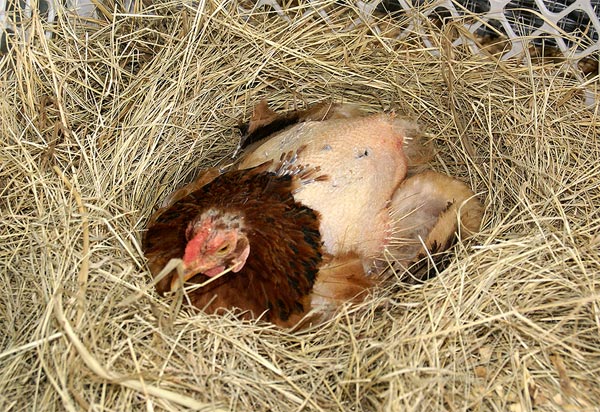
Content
What is molting in chickens and its features
Molting is a physiological process necessary for the body of chickens, as a result of which:
- Activation of the work of organs and systems in the body of the laying hen.
- Acceleration of the course of metabolic processes in the body of the chicken.
- Elimination of accumulated toxic substances acquired over the period since the previous renewal of the feather cover of a bird.
- Stimulation of the production of protein compounds involved in the growth of a new feather cover and the formation of eggs.
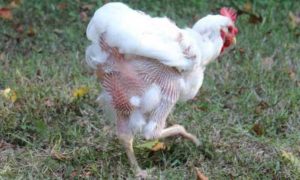
Important! During molting, chickens temporarily stop sexual activity and the work of the reproductive system, and therefore the production of eggs.
The cover renewal procedure consists of successive withering away and subsequent loss of old feathers with replacement with new regrowth structures. Reducing the duration of the operation leads to an acceleration in the time of the beginning of laying, the quantitative indicators of which, with the correct course of the process, can even increase.
How long does molt last and can it be accelerated
Depending on the variety, the procedure captures different time intervals, which take:
- Pen reset time at autumn molt fluctuates in the range of 50-55 days, after which a period of growth of new structures begins.
- Updating the feather cover in summer the period takes a shorter interval and fluctuates in the time interval of 21-30 days.
Note! A rapid, unprovoked moulting course may indicate a chicken disease.
The rate at which the feather renewal process takes place depends on:
- chicken breeds;
- type of procedure;
- health and physical condition of the laying hen.
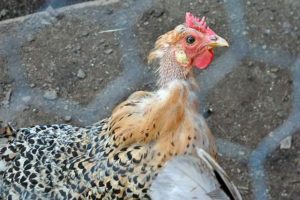
The normal molt duration for an adult is considered to be in the range of 8 to 14 weeks. The farmer can shorten this period to 5 weeks, causing the so-called compulsory molt.
Important! In order to reduce the time it takes for a chicken to change its feather cover, the breeder can use a special diet containing vitamins and stimulating substances.
Types of molting in chickens
Depending on the life cycles experienced by the laying hen, breeders distinguish such types of feather change (molting) in chickens as:
- primary consists in replacing the primary feather in chickens with a root, secondary, the passage time of which depends on the direction and breed of chickens. This procedure takes place at the stage of active formation of organs and systems, which lasts until the start of oviposition;
Note! Laying hens egg type feather change occurs several weeks earlier than other species at 4 weeks of age, compared to chickens meat and egg and meat directions for which this event occurs, starting from 5-6 weeks of life.
- provoking carried out by the breeder during July-August with the help of zootechnical, hormonal and chemical agents. The duration of such a procedure ranges from 1.5-2 months and is characterized by the replacement of feathers in the entire livestock at the same time;
Important! This type of moulting, if used improperly, can be harmful to the health of the bird, and therefore veterinarians recommend that only experienced farmers perform it. After agreement and preliminary consultation with a veterinarian, it is permissible to carry out such a procedure, provided that healthy individuals are selected, the breeder provides adequate nutrition, including the necessary supplements, and the creation of conditions close to optimal for keeping the birds.
- natural, the onset of which is due to age-related changes in the body of the laying hen. Usually, the onset of this event correlates with a drop in egg production and falls on the 14-15th month of the quail's life. The shedding of feathers begins from the neck, gradually covering the area of the back and trunk;
Note! The nature of the flow and the speed of this type of feather change allows the breeder to cull individuals with low productivity and replace them with young birds. A characteristic feature of the process is that chickens with low egg production rates are distinguished by a slow and even course of the procedure.
- painful occurs due to a malfunction of the hormonal system, the use of an improper diet, stress experienced, associated, for example, with a change of residence, the presence of pathologies in the chicken's body.
Important! If this type of molt is detected, it is recommended to check the conditions in the hen house, the quality of the laying hen's food and, if necessary, seek qualified help from a veterinarian.
- seasonal changing the pen is associated with preparation for changes in weather conditions, increase or decrease in ambient temperature.
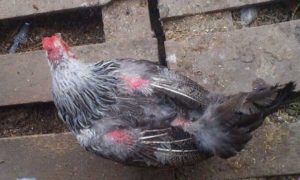
Regardless of the reasons that caused the molt, with a complete or partial change of feathers in a bird, the breeder, before panicking, should find out the reasons for the phenomenon. If the cause is a disease, it is necessary to take sanitary and therapeutic measures to improve the health of the livestock, if molting is caused by physiological processes in the body of the laying hen, it is necessary to change the diet and conditions of the chicken.
Seasonal types of molt
Experts distinguish 4 types of seasonal change of feathers, while it should be noted that each of them has characteristic features:
- spring runs from March to April, getting rid of the excess amount of warming feathers in preparation for warm weather;
- summer occurs in July, its duration is 20-28 days. Its characteristic features include a slow change of feathers, the opposite situation is a pathological course of the process;
Note! Some experts believe that this type of procedure does not apply to physiological cycles and indicates the presence of failures in the functioning of the laying hen's body.
- autumn differs in the loss and replacement of feathers on most of the body surface. The beginning of this process falls on the end of August - September, the duration of the process in this case ranges from 50-55 days. Replacing rare feathers with a dense cover allows the bird to survive the winter cold;
- winter the change of feather is not due to the need, and therefore experts attribute it not to seasonal types of molting, but to pathologies associated with the defeat of the bird's body by invasive forms, skin parasites, and various types of infectious diseases.
Artificial molting: why and how it is called
The provoked change of feathers is achieved using special methods and is carried out in order to increase egg production in chickens. Given the complexity of the procedure, it is most often used for the industrial maintenance of layers, which, however, does not exclude the operation at home. Experts identify two ways to carry out the forced renewal of feathers, including the use of chemical and hormonal drugs or using traditional medicine methods. However, before using any of the methods for artificially changing the cover of a bird, you must:
- Assess the health of the herd and exclude the procedure in unhealthy chickens.
- Conduct a blood test of selected layers for the presence of pathogenic microflora.
- Bring the living conditions in the hen house in line with the zootechnical and veterinary and sanitary standards.
Important! Experienced breeders recommend artificial renewal of bird plumage in spring and autumn, during periods of prolonged molting.
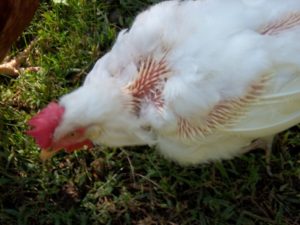
A provoked change of feather and part of the skin in chickens is achieved by using methods such as:
- Hormone consists in facilitating the disposal of old feathers and accelerating the formation of new structures. This effect is achieved by adding such drugs as thyrsoidine, progesterone, thyroxine to the diet of layers.
- Chemical It is based on slowing down the production of hormones by the organs of the reproductive system of layers and inhibiting the function of the pituitary gland, achieved by adding special concentrates to food containing substances such as nilevar, calcium, protamon, iodine. The use of these components is a stressful situation for the laying hen, however, after the cancellation of the reception of the listed funds, the bird's body is quickly restored.
- Classical the method is based on adjusting the regime of keeping chickens and has found wide application when it is necessary to increase productivity in conditions of industrial keeping of queens. The procedure may include reducing the length of daylight hours, using restrictions on the laying hens' access to food and drink. The zootechnical method involves depriving birds of food and limiting fluid intake for 4 days, during which they experience a stressful situation that accelerates the shedding of old feathers.
Note! After fasting, it is important to maintain the correct regimen for returning layers to feeding. If the procedure is performed correctly, experts note an increase in egg production and an increase in the resistance of the chicken's body to the action of viruses and infections in comparison with the natural change of the feather cover.
Reasons for shedding feathers or why chickens lose feathers due to molting
Among the factors provoking the onset of a change in feather cover by chickens, experts call:
- Insufficient amount of nutrients in the diet, therefore, in the body of the hen.
- The transition between age stages, which are replaced in the life cycle of a bird.
- During the preparation of the body for the change of natural seasons, as a result of the preparation of the chicken for cold or heat.
- In response to postponed events perceived as stress
However, inexperienced farmers sometimes confuse the natural course of physiological changes in the body of the bird with pathological processes, which results in the loss of a significant part of the livestock.
What can be confused with molting or other reasons for feather loss in chickens
Insufficient experience with respect to the nature and rate of flow of various types of feather renewal in chickens leads to the fact that some breeders confuse the natural change of plumage with diseases. Full or partial loss of feathers can occur:
- when the cover is affected by ticks and downy eaters;
- as a result of damage to the chicken's body by viruses or pathogenic microorganisms;
- in the presence of diseases of the skin;
- due to the stress caused by noise, collision with pets.
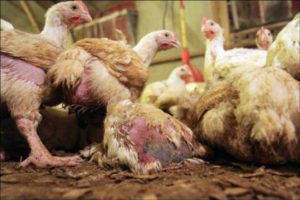
If you have any doubts about the nature of changes occurring with the livestock, it is recommended to seek the advice of a veterinarian.
How to care for chickens during molting
Correct maintenance of layers during cover renewal can speed up the process and, therefore, bring closer the time of laying renewal in chickens. Among the measures recommended during the molting period, one can single out:
- When caring for hens during moulting, keep in mind that changing cover is painful as the growing feather buds intersect with many blood vessels, and even minor trauma can lead to serious bleeding.
Important! It is necessary to limit tactile contact with the body of the chickens during the regrowth of the new coat.Intuitively realizing that this can lead to pain, birds themselves look for a secluded place to exclude contact with potential sources of unpleasant sensations.
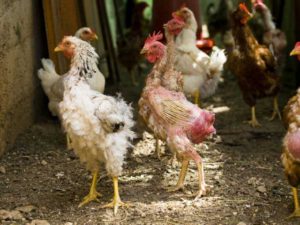
- Additional lighting should be provided in the hen house and the duration of daylight hours in layers should be increased to 14-15 hours.
- Eliminate stressful experiences associated, for example, with rotations in the herd structure.
- Carefully monitor the microclimate in the chicken coop, since the weakened body of the chicken at this moment is subject to any changes in humidity, temperature and the presence of drafts.
The listed measures will allow minimizing the possible negative consequences associated with the renewal of the cover in quads.
How to feed chickens during molting
However, the above measures are not able to fully ensure the successful course of the procedure without adjusting the diet. Experienced farmers know that during this period, by using a special diet, you can speed up the molting process and make it easier for poultry. Among the measures used for this, they call:
- Adding vitamins of group A, B1, B3, D to food, as well as the intake of such microelements as manganese and iodine into the body of the bird. These substances are found in sufficient quantities in boiled vegetables, fresh grass, berries and fodder beets.
- The supply of mineral components to the body can be ensured by adding to the diet of chalk, cottage cheese, wood ash and shells.
- Adding an additional amount of protein to the diet of laying hens, the amount of which should exceed the norms used with the usual type of chicken nutrition by no more than 5%. Alfalfa, soybeans, fish waste, insects can be added to the chicken feed as a source of protein during molting.
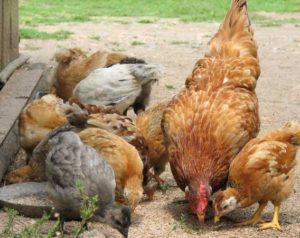
In addition to a balanced diet, it is important to provide access to food for all individuals from the herd, while it is necessary to impose no more than a one-time norm on the layers, since during this period of time the freshness of the feed has a dominant effect on the successful outcome of the procedure.
Molting refers to one of the physiological processes that periodically occur in a chicken herd. It can be caused by various reasons, however, it is important not to confuse the manifestations of feather renewal with feather dropping under the influence of a disease. Sometimes breeders themselves provoke the onset of molting, since after it an increase in productivity is noticed in layers. However, in this case, it is necessary to be extremely careful and use one of the methods of provoking an artificial change of cover only if you have sufficient experience.

